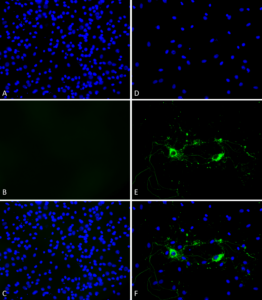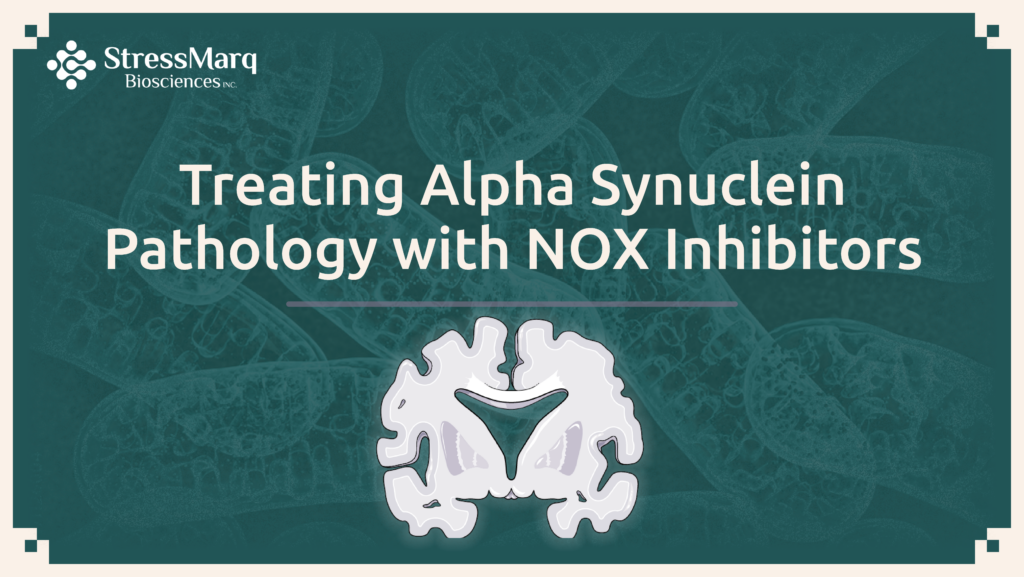Treating Alpha Synuclein Pathology with NOX Inhibitors
Reactive oxygen species (ROS) are unstable oxygen molecules that play essential roles in cell signaling and normal biological processes. However, under pathological conditions, excessive ROS production disrupts normal cellular physiology by readily reacting with DNA, RNA, and proteins. Mitochondria serve as both a major source and primary target of these ROS – their impairment, in turn, further increases ROS production. Oxidative stress, a key factor in dopaminergic (DA) neuronal damage, is also increased as a consequence of this cycle. The resulting depletion of dopamine levels within the brain primarily affects the striatum and substantia nigra pars compacta, key regions of the nigrostriatal system that regulate motor function. Significant dopamine depletion culminates in the characteric motor impairments observed in Parkinson’s disease (PD).
In addition to mitochondria, another major contributor to ROS production is nicotinamide adenine dinucleotide phosphate (NADPH) oxidase (NOX). ROS generation by NOX is closely linked to alpha synuclein aggregation. In an oxidative environment, misfolded alpha synuclein forms neurotoxic, insoluble aggregates known as Lewy bodies. These are capable of inducing significant neuronal dysfunction, neurodegeneration, and ultimately, neuronal cell death. Thus, targeting the NOX transmembrane receptor family presents a potential therapeutic strategy for reducing both pathological alpha synuclein accumulation and cellular oxidative stress.
Utility of NOX inhibitors
A study by Ofori et al., published in the International Journal of Molecular Sciences, demonstrated the neuroprotective effects of a NOX inhibitor in neurodegeneration. Compound-11, which specifically inhibits NOX-1, NOX-2, and NOX-4, was shown to reduce alpha synuclein fibrillar aggregation—a key driver of Parkinson’s disease pathology. This reduction was accompanied by decreased cytotoxicity and ROS generation. Furthermore, oral administration of Compound-11 alleviated motor deficits associated with Parkinson’s disease and helped rescue dopaminergic neuronal loss in the nigrostriatal brain regions, which are critical for movement control. The protective role of NOX inhibition in ROS regulation has previously been established within the context of cardiovascular and oncological diseases. With these latest findings, NOX inhibitors present a promising new therapeutic avenue for neurodegenerative diseases.
NOX inhibition in vitro
To begin the study, researchers from Delaware State University, USA, evaluated the effects of a NOX inhibitor in a neurodegenerative cellular model. Utilizing the N27 rat dopaminergic neural cell line alongside StressMarq’s Alpha Synuclein Pre-formed Fibrils (catalog #SPR-324), the molecular dysfunction observed in neurodegenerative diseases such as PD was modeled in vitro. These fibrillar alpha synuclein protein constructs promote the aggregation of endogenous monomeric alpha synuclein, precipitating the formation of toxic fibrillar aggregates. Notably, this process triggers mitochondrial dysfunction, activates NOX, and initiates other pathogenic cellular mechanisms.
Previous research by the same group had already identified NOX inhibition as a potential therapeutic strategy for PD. Given that NOX inhibition is able to mitigate ROS generation, the researchers investigated whether a NOX inhibitor could also reduce cellular ROS levels and protein aggregation. Compound-11, a small-molecule inhibitor of NOX isoforms 1, 2, and 4, was tested for this purpose. The resultant experimental data demonstrated that NOX inhibition successfully reversed key molecular disruptions associated with Parkinson’s disease by reducing cytotoxicity and enhancing cell viability.
Visualizing alpha synuclein aggregation
Before ROS generation and neuronal damage occur, key upstream molecular pathways involving alpha synuclein aggregation are activated. Therefore, the researchers sought to determine whether treatment with the NOX inhibitor affected these early protein aggregation events. As soluble alpha synuclein aggregates into fibrillar forms, its structure undergoes significant observable changes. Insoluble alpha synuclein PFFs are rich in beta-sheet structures, which can be readily identified using fluorescence dyes that selectively bind to these formations. One such dye, Thioflavin T, was employed in the study.
The results showed that Compound-11 reduced the accumulation of pathogenic fibrillar alpha synuclein by more than 35%. Additionally, the treatment significantly decreased ROS generation by 50%, further supporting its potential as a therapeutic strategy for mitigating oxidative stress and protein aggregation in PD.
Protective role of NOX inhibition in vivo
The next phase of the research honed in on whether the protective effects of NOX inhibition on neuronal loss in cellular models could be translated to pre-clinical models. To investigate this, researchers treated mice over 12 months of age with StressMarq’s Alpha Synuclein Pre-formed Fibrils (catalog #SPR-324). Notably, non-invasive oral administration of Compound-11 improved motor coordination and skills in treated mice, as evidenced by reduced grooming and climbing difficulties. Additionally, treated subjects exhibited greater motivation compared to control mice that did not receive the NADPH oxidase inhibitor.
To assess alpha synuclein aggregation, researchers employed the enzyme tyrosine hydroxylase, a marker of dopaminergic neurons, as its reduction in the nigrostriatal system has been demonstrated to impair dopamine synthesis. Compound-11 treatment partially reversed or prevented neuronal loss in both the striatum and substantia nigra—two brain regions crucial for movement control.
In Parkinson’s disease, alpha synuclein aggregation triggers phosphorylation due to conformational changes and kinase activation, leading to the formation of Lewy bodies. However, NOX inhibition reduced the pathological buildup of phosphorylated aggregates. Western blot analysis of brain tissues further confirmed that Compound-11 exerted a protective effect by specifically targeting NOX-1, NOX-2, and NOX-4 in the nigrostriatal regions.
Modelling Parkinson’s disease pathology with fibrillar StressMarq protein constructs
This study highlighted the protective role of NOX inhibition in reducing alpha synuclein aggregation, cytotoxicity, and ROS generation. By inducing Parkinson’s disease pathology using StressMarq’s Alpha Synuclein Pre-formed Fibrils (catalog #SPR-324), researchers were able to investigate the cellular and molecular effects of NOX inhibition in both in vitro and in vivo models. The findings demonstrated not only the reduction of pathogenic protein aggregation and oxidative stress in cellular models but also the alleviation of motor deficits in a physiological model. Such models are essential for understanding the molecular mechanisms underlying Parkinson’s disease and for developing potential therapeutic strategies to mitigate its symptoms and progression.

[Image from: StressMarq website] Primary rat hippocampal cells neurons with Lewy body formation treated with StressMarq’s Mouse Alpha Synuclein Pre-formed Fibrils (catalog# SPR-324).
Summary
NADPH oxidases (NOXs) are a family of electron-transporting membrane enzymes whose primary function is ROS generation. Growing evidence supports the protective role of NOX inhibition in mitigating the harmful effects of excessive ROS in pathological conditions such as cardiovascular disease and cancer. The novel findings by Ofori et al. highlight the neuroprotective potential of NOX inhibition via Compound-11, which reduces cytotoxicity in neuronal cells by preventing alpha synuclein fibrillar aggregation and ROS generation. These protective effects were further validated in pre-clinical models, where oral administration of the NOX inhibitor alleviated motor deficits in a model of PD. The findings presented in this study represent a significant milestone in developing therapeutic strategies for Parkinson’s disease while also contributing to the broader field of neurodegenerative disease research.
Related StressMarq Products
StressMarq’s diverse range of alpha synuclein protein constructs enables researchers to create high-quality in vitro and in vivo neurodegenerative disease models. Visit our website for more information, including the latest scientific publications using our specialized alpha synuclein, tau and amyloid beta proteins for neurodegenerative disease research.
References
- A novel NOX inhibitor alleviates Parkinson’s disease pathology in PFF-injected mice. Ofori, K. et al., Int J Mol Sci. 2023.
- A novel NOX inhibitor treatment attenuates Parkinson’s disease-related pathology in mouse models. Ghosh, A. A. et al., Int J Mol Sci. 2022.


Leave a Reply